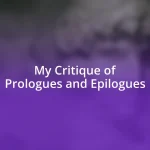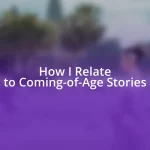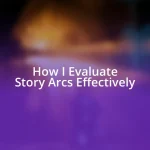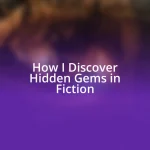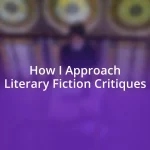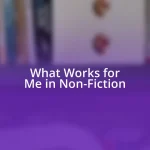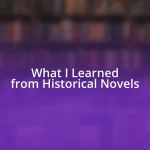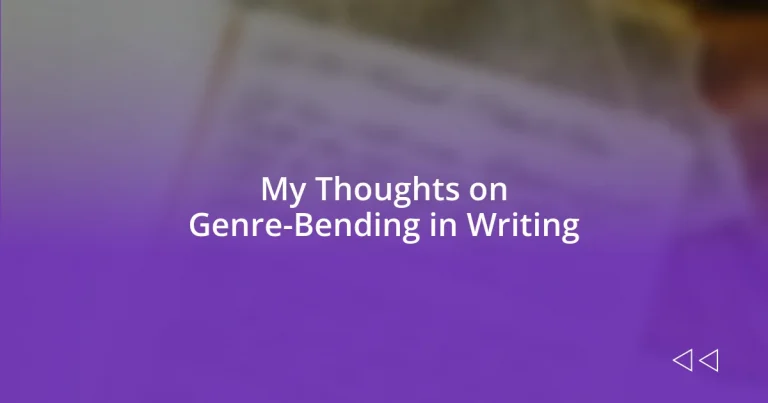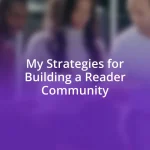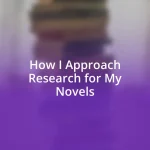Key takeaways:
- Genre-bending enriches storytelling by merging various genres, promoting creativity and innovation while reflecting the complexity of real-life experiences.
- Historical foundations of genre-bending span from ancient theatrical forms to modern postmodern literature and digital storytelling, leading to limitless narrative possibilities.
- Successful genre-bending requires a balance between maintaining coherent voice, meeting audience expectations, and managing pacing, as demonstrated in notable works like “American Gods” and “Get Out.”
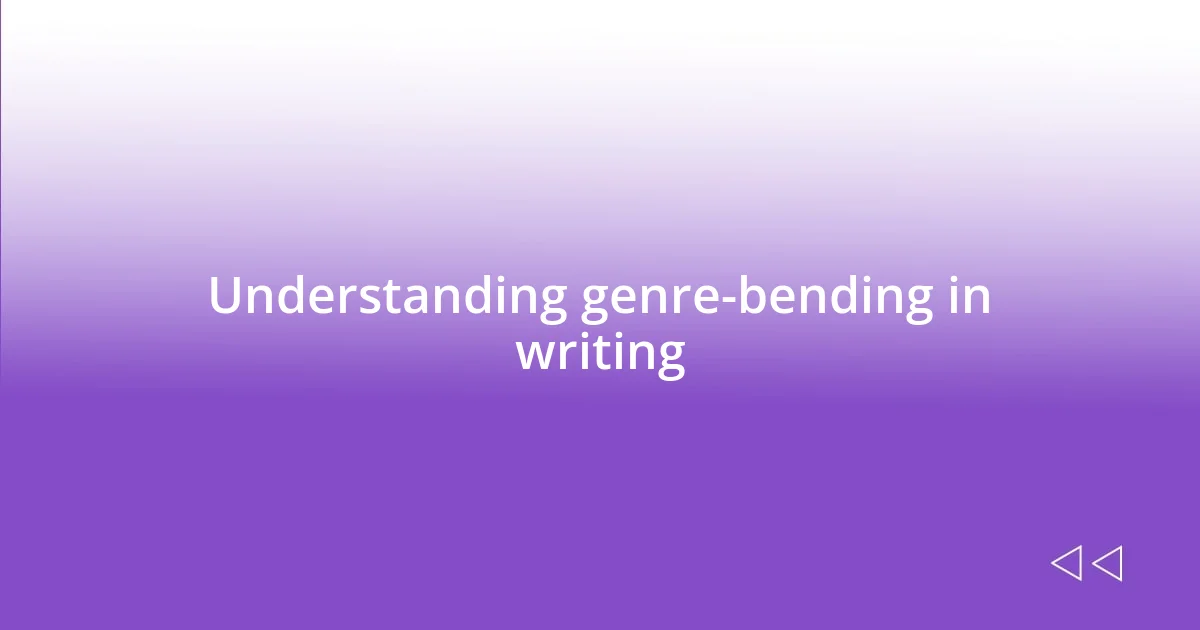
Understanding genre-bending in writing
Genre-bending in writing intrigues me because it defies the conventional boundaries we often impose on literature. I remember the first time I stumbled upon a novel that seamlessly blended science fiction and romance; it felt like stepping into a new universe where rules didn’t apply. It raises a question: why limit ourselves to strict categories when storytelling has so much potential?
When I think about genre-bending, I can’t help but reflect on how it mirrors real life, where experiences and emotions often overlap rather than fit neatly into boxes. Have you ever found yourself resonating with a character’s journey that tucked elements from various genres? I certainly have, and it made me realize the fluidity of our human experiences and the stories we share.
What excites me most is how genre-bending invites experimentation and innovation. There’s something liberating about taking familiar tropes and twisting them to create something wholly unique. For instance, a horror story laced with humor can deliver chills while also making you laugh—an unexpected combination. Isn’t that what makes reading such a rich experience? It pushes me to think: what genre expectations can I challenge in my own writing?
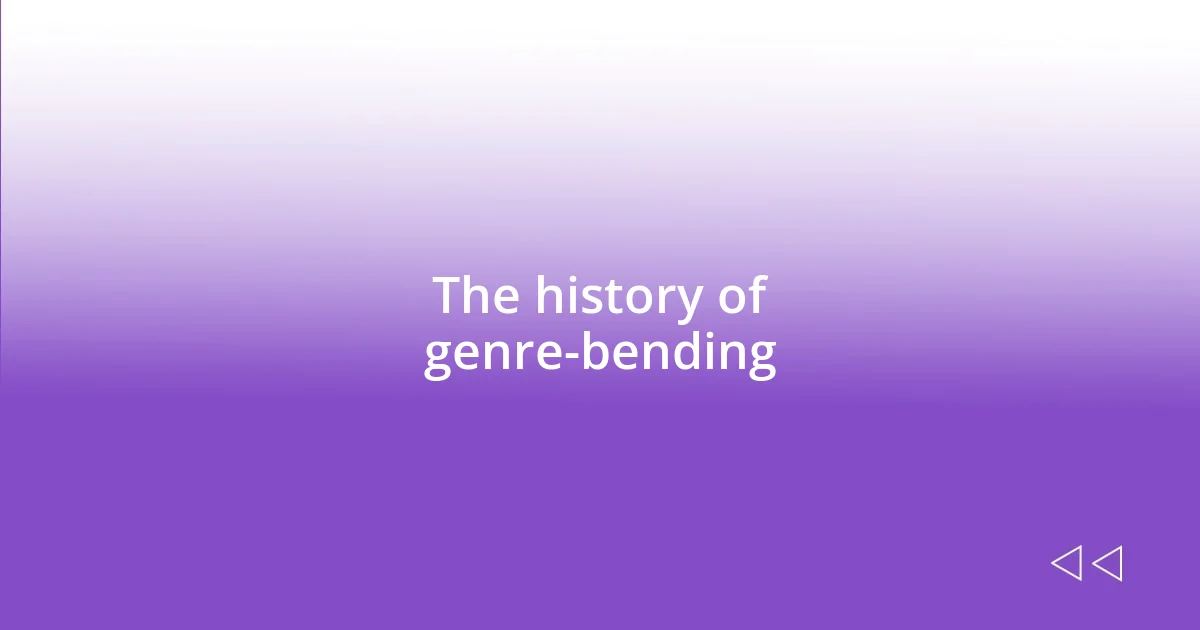
The history of genre-bending
The concept of genre-bending has roots that stretch back to antiquity, where ancient playwrights and epic poets often blended genres in their works. For instance, Aristotle discussed the blending of tragedy and comedy in his seminal text “Poetics,” illustrating how these forms could coexist. This historical overlap paved the way for modern writers to break conventions and mix genres without fear.
As we moved into the twentieth century, the emergence of postmodern literature further revolutionized genre-bending. Authors such as Thomas Pynchon and Don DeLillo infused their narratives with elements of science fiction, mystery, and absurdism. Their works made me realize that literature doesn’t have to adhere to strict formulas; it can be a playground for creativity. Isn’t it thrilling to explore narratives that refuse to fit into traditional molds?
More recently, the rise of multimedia and digital storytelling has amplified genre-bending in ways we never could have imagined. With the integration of interactive elements and hybrid forms, I can’t help but wonder how these advancements will shape future writing. For example, web narratives often merge elements of poetry, prose, and visual art, creating a rich tapestry of storytelling. It leads me to think about the limitless possibilities when we allow ourselves to experiment without boundaries.
| Historical Period | Genre-Bending Characteristics |
|---|---|
| Ancient Times | Blending of tragedy and comedy; foundational texts like Aristotle’s “Poetics.” |
| 20th Century | Postmodern literature combining sci-fi, mystery, and absurdism; authors like Pynchon and DeLillo. |
| Modern Era | Incorporation of multimedia; blending poetry, prose, and digital art in storytelling. |
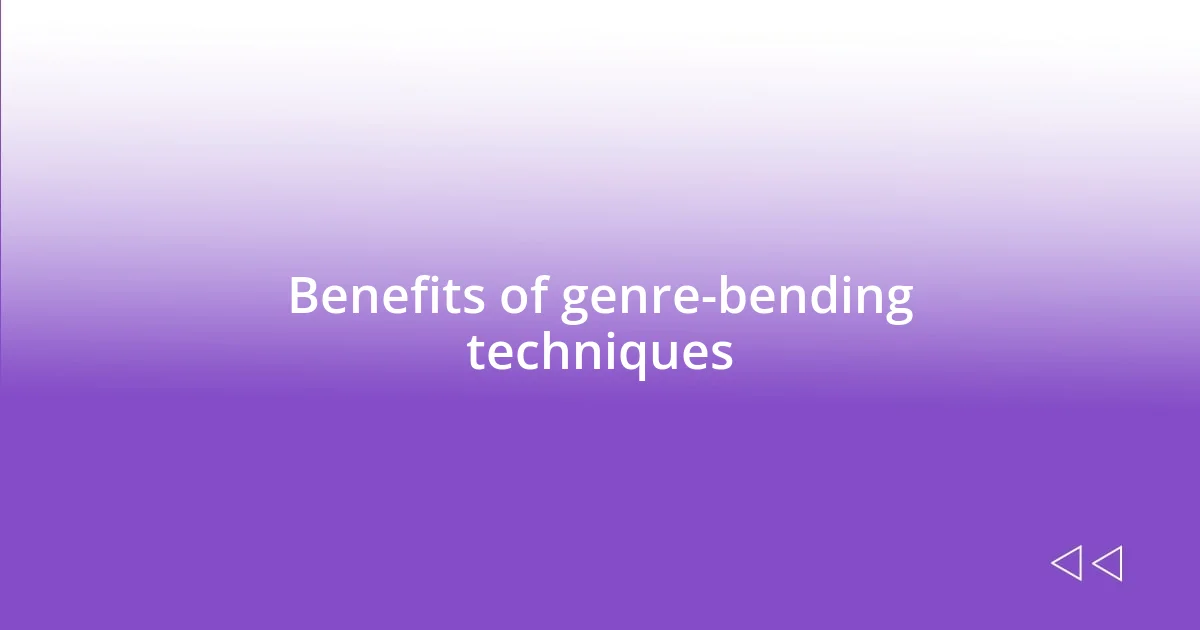
Benefits of genre-bending techniques
Exploring genre-bending techniques has opened my eyes to a plethora of benefits in writing. It fosters creativity, allowing authors to innovate beyond traditional frameworks. For example, when I tried blending elements of fantasy and crime in my writing, I discovered new narrative depths, letting characters explore morally ambiguous territories that I hadn’t encountered in either genre before.
- Enhanced creativity: Pushing beyond genre confines encourages fresh ideas and unique storytelling methods.
- Broader audience appeal: Genre-bending can attract readers who may not typically engage with a single genre, increasing a work’s reach.
- Complex characters: Mixing genres lets writers create multidimensional characters who are influenced by diverse experiences.
- Dynamic themes: Stories can explore intricate themes that resonate on multiple levels, providing richer emotional experiences.
I’ll never forget when I read a graphic novel that integrated horror and romance—it was unlike anything I’d experienced before. The chilling atmosphere contrasted beautifully with the tender moments between the characters, creating an emotional rollercoaster. This blend made me reconsider the potential of my own crafting, as it not only kept the reader engaged but also evoked a spectrum of feelings I thought only one genre could capture. I realized that playing with genres could truly enrich the storytelling experience.
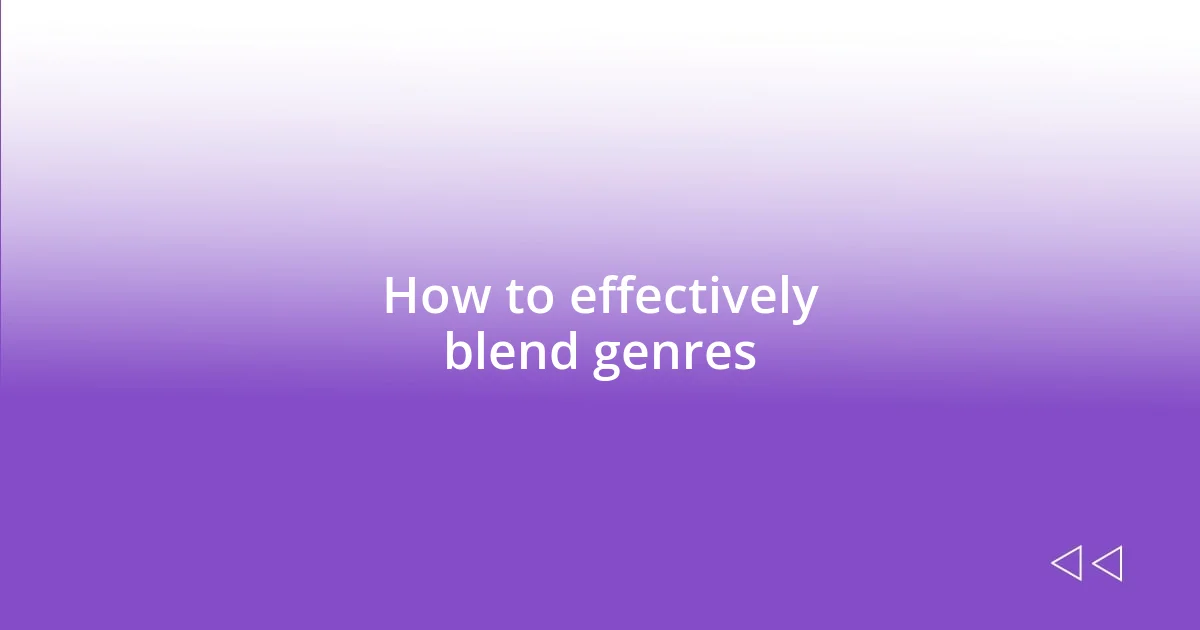
How to effectively blend genres
Blending genres effectively starts with understanding the core elements of each. I often ask myself, “What is it that draws me to a specific genre?” By identifying the aspects I love, I can weave them together with elements from another genre. For instance, if you’re captivated by the suspense of a thriller, think about how you could infuse that urgency into a more contemplative literary work. The interplay between tension and introspection can create a compelling narrative.
Another strategy is to create characters that resonate across genres. I remember crafting a protagonist who was a detective but also a reluctant hero in a fantasy world. This character’s dual nature didn’t just add layers to the story; it also allowed me to explore themes of duty versus desire in a way that felt fresh and relatable. Have you ever thought about how your character’s struggles might span across different settings? This approach invites readers to engage with the story on multiple levels, deepening their emotional investment.
Lastly, pay attention to tone and pacing, as these elements can either unify or clash in a blended genre. For example, in a project I was working on, I experimented with juxtaposing whimsical language typical of a children’s book with the darker, more adult themes of a horror story. The unexpected contrast made the narrative richer and kept my readers on their toes, constantly questioning what would happen next. Wouldn’t it be exciting to see how different tones can shape readers’ perceptions? The key lies in experimentation and trusting your instincts to connect the dots.
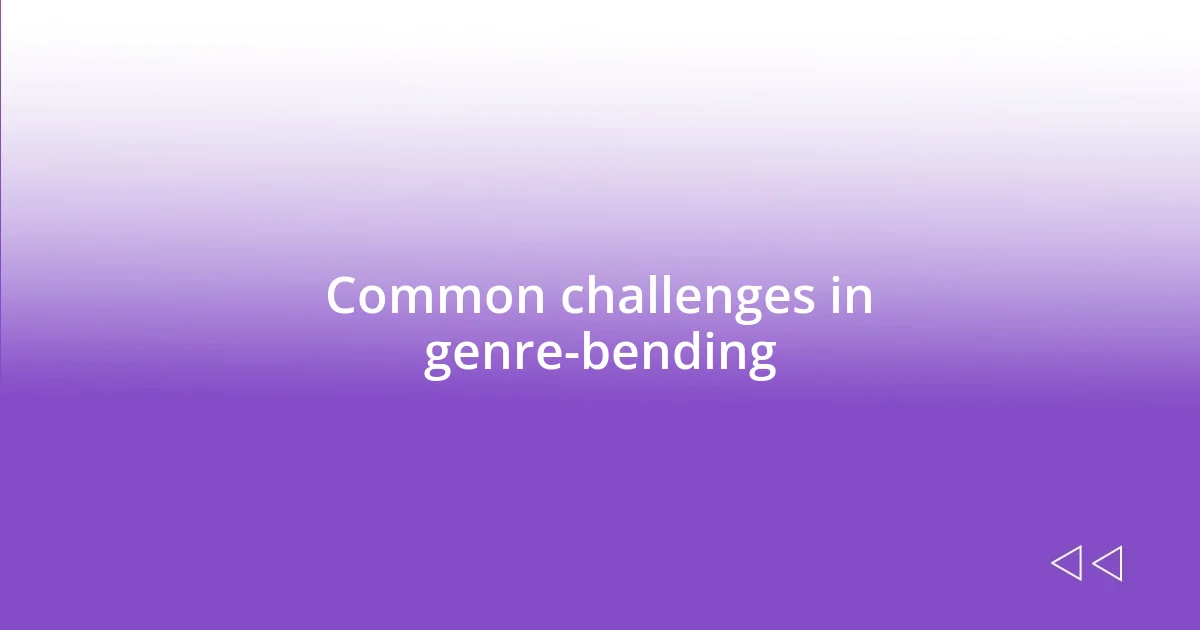
Common challenges in genre-bending
Blending genres may come with thrilling possibilities, but it also brings unique challenges that can be quite daunting. From my own experience, one of the biggest hurdles is maintaining a coherent voice. When I tried to mix the ominous tones of horror with the light-heartedness of a comedy, my writing felt like it had multiple personalities. There were moments when the shifts felt too jarring, leaving my readers confused rather than entertained. Have you ever finished a book and wondered, “What was the author trying to achieve?” That’s a question I always try to avoid for my work.
Another challenge I frequently encounter lies in audience expectations. Readers pick up a book for a specific genre because they crave certain elements, like suspense or romance. I remember releasing a short story that intertwined fantasy with romance, and I was met with mixed reactions. Some fans adored the unexpected blend, while others felt compelled to point out the lack of traditional romantic tropes. It reminded me of how important it is to strike a balance between innovation and familiarity. How do we meet reader expectations while also pushing boundaries?
Lastly, the pacing of a genre-bending narrative can be tricky to navigate. In one of my attempts to combine science fiction with historical fiction, I found myself caught between futuristic timelines and the slower, rich details of the past. I had to ask myself, “How do I keep the story moving without losing the depth?” It was a fine line to walk, but ultimately, I learned that pacing needs to feel organic. An abrupt shift can pull readers out of the world you’ve created, and that’s the last thing you want. Each challenge, while formidable, taught me valuable lessons about storytelling that I apply in my writing today.
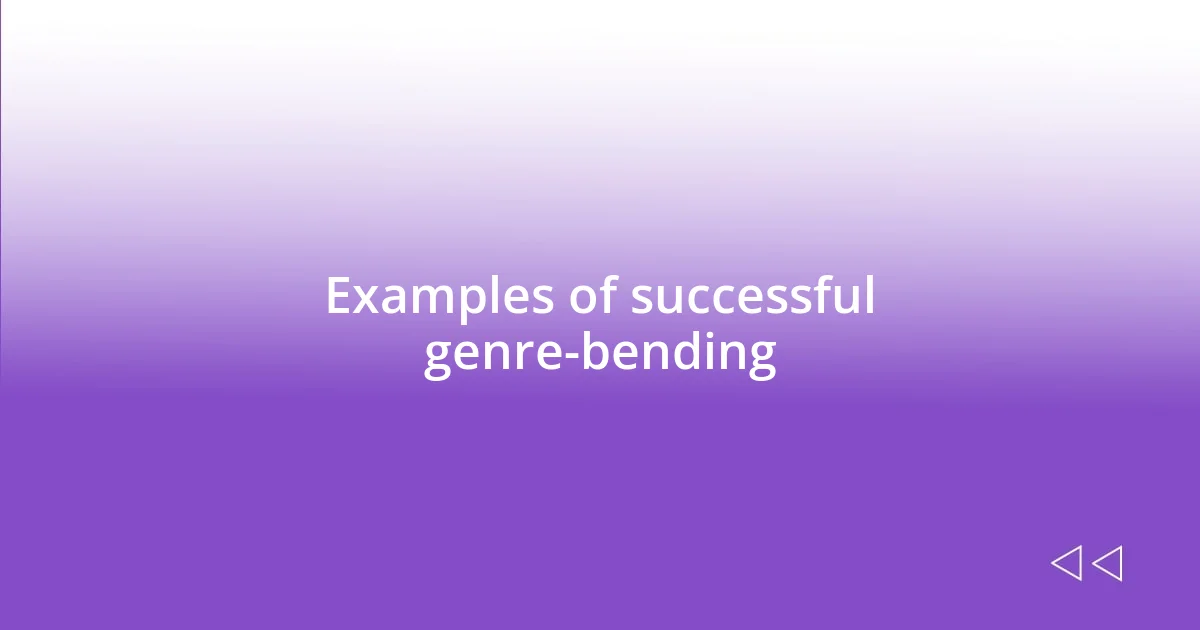
Examples of successful genre-bending
When I think of successful genre-bending, one standout example is Neil Gaiman’s “American Gods.” Gaiman masterfully intertwines urban fantasy with magical realism, showcasing how ancient deities coexist in modern America. This layering allowed me to reflect on cultural identity and belief, elements that resonate deeply with readers who may grapple with similar themes in their lives.
Another fascinating instance is the graphic novel “Saga” by Brian K. Vaughan and Fiona Staples. With its blend of space opera and fantasy, this series explores complex issues like love and war, wrapped in the tapestry of interstellar adventure. I can’t help but admire how the combination of striking visuals and heartfelt storytelling creates a highly relatable narrative, making me question: how often do we encounter stories that speak to both our imaginative and emotional sides?
A more unconventional example is the film “Get Out,” which blends horror, suspense, and social commentary. Jordan Peele uses elements of the horror genre to tackle critical societal issues, prompting audiences to confront uncomfortable truths. This brilliant fusion left me pondering the power of genre-bending—how can it serve as a mirror to society while simultaneously entertaining us? The capacity to provoke thought and spark dialogue truly embodies the beauty of blending genres in art.
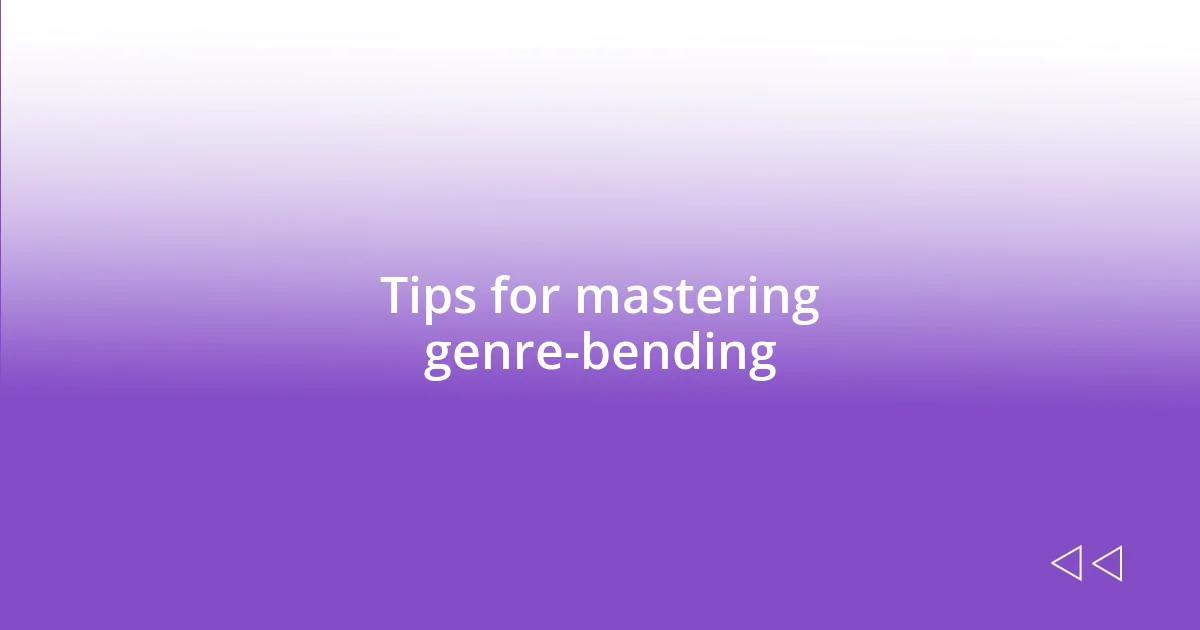
Tips for mastering genre-bending
When it comes to mastering genre-bending, I’ve learned that understanding the core elements of each genre you wish to blend is crucial. Early in my writing journey, I attempted to fusing horror with romance but realized I had to nail the emotional stakes of both. This meant truly grasping what makes my readers shudder in fear while also swooning at romantic moments. Have you ever tried to capture the essence of both despair and love in one paragraph? It can be a delightful challenge.
One technique I’ve found effective is to create relatable, multidimensional characters. In a recent project where I mixed thriller with science fiction, I focused on building a protagonist whose fears and aspirations straddled both worlds. This approach not only anchored my narrative for readers but also kept them invested emotionally. Don’t you love it when a character feels so real that their journey becomes your own?
Additionally, I highly recommend experimenting with tone and style. Each blend of genres allows you to play with different narrative techniques. In one short story, I intertwined the whimsy of magical realism with stark realism, crafting a whimsical yet grounded world. This dynamic shift in tone taught me to embrace contrast rather than shy away from it. How do you think contrasting tones can enhance a story’s impact? For me, it has opened doors to limitless creative potential.
